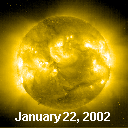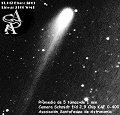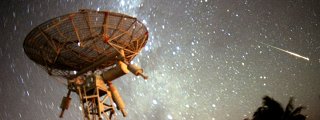|   SPACE WEATHER SPACE WEATHER
Current
Conditions
Solar Wind
velocity: 370.4 km/s
density:3.5 protons/cm3
explanation | more data
Updated: Today at 2255 UT
X-ray Solar Flares
6-hr max: C2 2205 UT Jan22
24-hr: C9 0900 UT Jan22
explanation | more data
Updated: Today at 2245 UT
Daily Sun: 22 Jan '02 
None of the active regions on the Sun today pose a substantial threat for major eruptions. Image credit: SOHO/MDI
The Far Side of the Sun

This holographic image reveals one or more substantial active regions on the far side of the Sun. Image credit: SOHO/MDI
Sunspot Number: 187
More about sunspots
Updated: 21 Jan 2002
Radio Meteor Rate
24 hr max: 19 per hr
Listen to the Meteor Radar!
Updated: 22 Jan 2002 Interplanetary Mag. Field
Btotal: 6.0 nT
Bz: 3.5 nT north
explanation | more data
Updated: Today at 2256 UT Coronal Holes:

There are no substantial coronal holes on the Earth-facing side of the Sun. Image credit: SOHO Extreme UV Telescope.
More about coronal holes
 SPACE WEATHER SPACE WEATHER
NOAA
Forecasts
Solar Flares: Probabilities for a medium-sized (M-class) or a major (X-class) solar flare during the next 24/48 hours are tabulated below.
Updated at 2002 Jan 22 2200 UT
| FLARE | 0-24 hr | 24-48 hr | | CLASS M | 50 % | 50 % | | CLASS X | 05 % | 05 % |
Geomagnetic Storms: Probabilities for significant disturbances in Earth's magnetic field are given for three activity levels: active, minor storm, severe storm
Updated at 2002 Jan 22 2200 UT Mid-latitudes | 0-24 hr | 24-48 hr | | ACTIVE | 15 % | 15 % | | MINOR | 01 % | 01 % | | SEVERE | 01 % | 01 % |
High latitudes | 0-24 hr | 24-48 hr | | ACTIVE | 20 % | 20 % | | MINOR | 05 % | 05 % | | SEVERE | 01 % | 01 % |

Web server provided by
VPS Hosting | What's Up in Space -- 22 Jan 2002
Subscribe to Space Weather News! ASTEROID FLYBYS: A pair of asteroids are close to Earth this week: 4660 Nereus and newly-discovered 2002 AL31. 2002 AL31 is a dim space rock, perhaps only 35 meters wide, that will glide by our planet 6 times farther away than the Moon on Jan. 23rd. 4660 Nereus, which was 11 lunar distances from Earth on Jan. 22nd, is large -- about 1-km across -- but even harder to see than 2002 AL31. At closest approach Nereus was situated almost directly between the glaring Sun and Earth, with its night side facing our planet.  SOUTHERN COMET: Comet LINEAR (C/2000 WM1) has arrived at perihelion (closest approach to the Sun). On Jan. 22nd it was only 0.55 AU from our star. Southern hemisphere sky watchers can see the 6th magnitude comet with binoculars or -- just barely -- with the unaided eye. Argentine astronomers Gustavo Mazalán, Víctor Buso and Mariano Ascheri captured this image of the comet on Jan. 17th. Click on the photo for details. SOUTHERN COMET: Comet LINEAR (C/2000 WM1) has arrived at perihelion (closest approach to the Sun). On Jan. 22nd it was only 0.55 AU from our star. Southern hemisphere sky watchers can see the 6th magnitude comet with binoculars or -- just barely -- with the unaided eye. Argentine astronomers Gustavo Mazalán, Víctor Buso and Mariano Ascheri captured this image of the comet on Jan. 17th. Click on the photo for details.
THE RESURGENT SUN: Evidence is mounting that some solar cycles are doubled-peaked. The ongoing solar maximum itself appears to be "a double" -- and the second peak has arrived. Catch the full story from Science@NASA.  AURORAS: Solar wind gusts flowing from a small coronal hole buffeted our planet's magnetosphere last weekend. On Jan. 19th geomagnetic activity increased for a while and high-latitude sky watchers spotted beautiful Northern Lights -- like these green auroras competing with the city lights of Rovaniemi, Finland, near the Arctic Circle. Photo credit: Denis Joye. Details: 8 sec. exposure; Epson PC3000Z digital camera; Jan. 19, 2002; 10 p.m. local time. [more] AURORAS: Solar wind gusts flowing from a small coronal hole buffeted our planet's magnetosphere last weekend. On Jan. 19th geomagnetic activity increased for a while and high-latitude sky watchers spotted beautiful Northern Lights -- like these green auroras competing with the city lights of Rovaniemi, Finland, near the Arctic Circle. Photo credit: Denis Joye. Details: 8 sec. exposure; Epson PC3000Z digital camera; Jan. 19, 2002; 10 p.m. local time. [more]
RETURN OF THE LEONIDS: The 2001 Leonid meteor storm is over, but beautiful pictures of the shower continue to appear. In this one, captured by Michael Pique, a Leonid streaks past the South Celestial Pole over Australia. [more]  WEB LINKS: NOAA FORECAST | GLOSSARY | SPACE WEATHER TUTORIAL | LESSON PLANS | BECOME A SUBSCRIBER | 
Potentially Hazardous Asteroids (PHAs) are space rocks larger than approximately 100m that can come closer to Earth than 0.05 AU. None of the known PHAs are on a collision course with our planet, although astronomers are finding new ones all the time.
On 22 Jan 2002 there were 373 known Potentially
Hazardous Asteroids Jan. 2002 Earth-asteroid encountersNotes: LD is a "Lunar Distance." 1 LD = 384,401 km, the distance between Earth and the Moon. 1 LD also equals 0.00256 AU. MAG is the visual magnitude of the asteroid on the date of closest approach. 
- HOT COMET: Periodic comet 96P/Machholz put on a dazzling show as it swung by the Sun on Jan. 8, 2002.
- ASTEROID FLYBY: Asteroid 2001 YB5 raced past Earth on Jan. 7, 2002, only two times farther away than the Moon. [gallery]
- SUBTLE ECLIPSE: The Moon dipped into the outskirts of Earth's shadow on Dec. 30, 2001. [gallery]
- MOON & SATURN: The Moon keeps getting in the way of Saturn! See the series of close encounters here.
- CHRISTMAS LIGHTS: On Christmas Eve, 2001, a solar wind stream triggered Northern Lights. [gallery]
- SOLAR ECLIPSE: Sky watchers in Hawaii and most parts of North America experienced a partial solar eclipse on Dec. 14th. [gallery]
- BRIGHT ASTEROID: Videos and images of 1998 WT24 -- a big and bright near-Earth asteroid that came close to our planet on Dec. 16, 2001. [gallery]
- NORTHERN LIGHTS: On Nov. 24th a pair of coronal mass ejections swept past Earth and triggered worldwide auroras.
- LEONIDS 2001: Some people saw it. Others heard it. In either case, they'll never forget it: The 2001 Leonid meteor storm.
- PERSEIDS 2001: Perseid watchers on August 12th spotted meteors, auroras, and a disintegrating Russian rocket! [gallery]
- MORNING PLANETS: In July and Aug. 2001, the Moon, Jupiter, Saturn, Venus, and Mercury put on a dazzling early-morning sky show. [gallery]
- ECLIPSE SAFARI: Onlookers cried out in delight on June 21, 2001, when the Moon covered the African Sun, revealing the dazzling corona. [gallery]
- TOTAL LUNAR ECLIPSE: On Jan. 9, 2001, the full Moon glided through Earth's copper-colored shadow. [gallery]
- CHRISTMAS ECLIPSE: Sky watchers across North America enjoyed a partial solar eclipse on Christmas Day 2000 [gallery]
- LEONIDS 2000: Observers around the globe enjoyed three predicted episodes of shooting stars. [gallery]
 Nov. 7 , 2001: What Lies beneath a Sunspot -- Awesome plasma hurricanes were one of the surprises revealed when scientists peered beneath the stormy surface of our star. Oct. 26 , 2001: 'tis the Season for Auroras -- Autumn is a good time to spot Northern Lights. Oct. 17, 2001: Halley's Comet Returns ... in bits and pieces -- The annual Orionid meteor shower peaks on October 21st. Aug. 9, 2001: Horse Flies and Meteors -- Like bugs streaking down the side window of a moving car, long and colorful Perseid Earthgrazers could put on a remarkable show on August 11th. July 27, 2001: Meteorites Don't Pop Corn -- A fireball that dazzled Americans on July 23rd probably didn't scorch any cornfields, contrary to widespread reports. June 12, 2001: The Biggest Explosions in the Solar System -- NASA's HESSI spacecraft aims to unravel an explosive mystery: the origin of solar flares. |

